INSTITUT SUPERIEUR D'ANTHROPOLOGIE
INSTITUTE OF ANTHROPOLOGY
ONLINE COURSES / COURS A DISTANCE
SPRING TERM : APRIL 2015
REGISTER NOW
ROYAUME UNI – 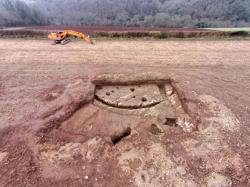 Spriddlestone - After a dig launched to culminate years of theorising by Howard Jones, a local archaeologist and former Royal Marine whose suspicions were strengthened by Google Maps, archaeologists are about to compile their findings from a set of four riverside fields near Plymouth which could have been part of one of Devon’s oldest settlements.A wealth of artefacts from the Roman and medieval periods have already been identified since the two-week initial phase of the dig ended last weekend. Having made his way across the fields in pursuit of convincing preparatory evidence, Jones found receptive allies in the form of rugby club hosts, volunteers from local history and archaeology societies and local newspaper the Western Morning News. “The finds from the field walking include a good assemblage of flints, from the Mesolithic to Early Bronze Age. “There are plenty of post-medieval and later pottery sherds and an amazing amount of small medieval sherds - South Devon Wares and St Germans Wares - most likely derived from Spriddlestone House. “There were a small number of sherds of 15th and 16th century luxury imported pottery types, which may support them being of high-status origin, prior to being spread on the fields, presumably with the rest of the domestic rubbish, as manure.” “The most interesting of the trenches revealed part of a late Iron Age or Romano-British roundhouse which had been cut into the hillside. “This house appears to relate to the ‘final’ phase of settlement on the site, and had in fact cut - overlay and partly truncated - a ditch associated with the settlement enclosures identified on the geophysics. This suggests that we have at least two phases of Iron Age settlement on the site, and that the first phase, or at least parts of it, had gone out of use long enough for the ditches to largely silt up and be forgotten prior to the second phase being constructed. “All of the excavated features appear to have been of Iron Age date, but within the excavations and from the fieldwalking and metal detecting finds there is enough evidence to suggest that there had been a phase of Bronze Age activity - possibly field systems and settlement - on the site. “It could also have been utilised during the later stone age, both in the Mesolithic and Neolithic periods, perhaps as a temporary or seasonal camp. They were certainly on site long enough to make flint tools – lots of debitage, flint waste flakes.”
Spriddlestone - After a dig launched to culminate years of theorising by Howard Jones, a local archaeologist and former Royal Marine whose suspicions were strengthened by Google Maps, archaeologists are about to compile their findings from a set of four riverside fields near Plymouth which could have been part of one of Devon’s oldest settlements.A wealth of artefacts from the Roman and medieval periods have already been identified since the two-week initial phase of the dig ended last weekend. Having made his way across the fields in pursuit of convincing preparatory evidence, Jones found receptive allies in the form of rugby club hosts, volunteers from local history and archaeology societies and local newspaper the Western Morning News. “The finds from the field walking include a good assemblage of flints, from the Mesolithic to Early Bronze Age. “There are plenty of post-medieval and later pottery sherds and an amazing amount of small medieval sherds - South Devon Wares and St Germans Wares - most likely derived from Spriddlestone House. “There were a small number of sherds of 15th and 16th century luxury imported pottery types, which may support them being of high-status origin, prior to being spread on the fields, presumably with the rest of the domestic rubbish, as manure.” “The most interesting of the trenches revealed part of a late Iron Age or Romano-British roundhouse which had been cut into the hillside. “This house appears to relate to the ‘final’ phase of settlement on the site, and had in fact cut - overlay and partly truncated - a ditch associated with the settlement enclosures identified on the geophysics. This suggests that we have at least two phases of Iron Age settlement on the site, and that the first phase, or at least parts of it, had gone out of use long enough for the ditches to largely silt up and be forgotten prior to the second phase being constructed. “All of the excavated features appear to have been of Iron Age date, but within the excavations and from the fieldwalking and metal detecting finds there is enough evidence to suggest that there had been a phase of Bronze Age activity - possibly field systems and settlement - on the site. “It could also have been utilised during the later stone age, both in the Mesolithic and Neolithic periods, perhaps as a temporary or seasonal camp. They were certainly on site long enough to make flint tools – lots of debitage, flint waste flakes.”
http://www.culture24.org.uk/history-and-heritage/archaeology/art521163-devon-fields-could-have-been-prehistoric-camp-and-romano-british-roundhouse-say-archaeologists
INDE – 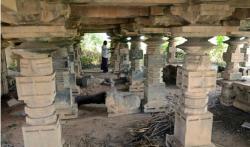 Kusumanchi - After much delay, work has finally begun on restoration of two ancient temples of the Kakatiya era in Kusumanchi mandal headquarters in the district. The two ancient temples, reportedly dating back to the 12th century, were built during the reign of Kakatiya dynasty. The area surrounding the two temples is dotted with some archaeological monuments including a megalithic menhir (a vertical standing stone). The entire stretch of the area known for its archaeological significance has been left in shambles due to lack of proper protection, rued V Sagar of Kusumanchi.
Kusumanchi - After much delay, work has finally begun on restoration of two ancient temples of the Kakatiya era in Kusumanchi mandal headquarters in the district. The two ancient temples, reportedly dating back to the 12th century, were built during the reign of Kakatiya dynasty. The area surrounding the two temples is dotted with some archaeological monuments including a megalithic menhir (a vertical standing stone). The entire stretch of the area known for its archaeological significance has been left in shambles due to lack of proper protection, rued V Sagar of Kusumanchi.
http://www.thehindu.com/todays-paper/tp-national/tp-telangana/restoration-of-two-kakatiya-era-temples-in-full-swing/article7009710.ece
TURQUIE – 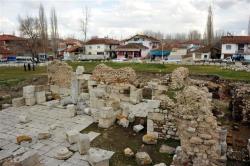 Sebastapolis - The northern province of Tokat’s Sulusaray district, a settlement of 3,500 people located on top of the ancient city of Sebastapolis, is set to be moved to another location so that the site can come to light.Sulusaray Mayor Halil Demirkol said the ancient city, which has been home to three civilizations, was located in the center of the district. Excavation work was carried out here in the 1990s but it stopped for some reasons. After a 22-year hiatus, excavations started again three years ago and are continuing with the collaboration of Gaziosmanpaşa University, the museum directorate, the Culture and Tourism Ministry and the Special Provincial Directorate. This is a long-term work. It may take 30-40 years to unearth the ancient city. The ancient city of Sebastapolis was established in the 1st century B.C. The city was included in the Cappadocia region after being separated from the Pontus Galatius and Polemoniacus states at the time of the Roman Emperor Trajan between 98 and 117 A.D. It was known as one of the five largest cities in the Black Sea region 2,000 years ago because it was located on passageways and because of its thermal sources, which are still being used today. As an indicator of its wealth at the time of the Roman Empire, Sebastapolis had the authority to print money. Scholars believe that the city lost its importance and was forgotten over time, largely due to big wars, destruction, disasters and changes to passageways.
Sebastapolis - The northern province of Tokat’s Sulusaray district, a settlement of 3,500 people located on top of the ancient city of Sebastapolis, is set to be moved to another location so that the site can come to light.Sulusaray Mayor Halil Demirkol said the ancient city, which has been home to three civilizations, was located in the center of the district. Excavation work was carried out here in the 1990s but it stopped for some reasons. After a 22-year hiatus, excavations started again three years ago and are continuing with the collaboration of Gaziosmanpaşa University, the museum directorate, the Culture and Tourism Ministry and the Special Provincial Directorate. This is a long-term work. It may take 30-40 years to unearth the ancient city. The ancient city of Sebastapolis was established in the 1st century B.C. The city was included in the Cappadocia region after being separated from the Pontus Galatius and Polemoniacus states at the time of the Roman Emperor Trajan between 98 and 117 A.D. It was known as one of the five largest cities in the Black Sea region 2,000 years ago because it was located on passageways and because of its thermal sources, which are still being used today. As an indicator of its wealth at the time of the Roman Empire, Sebastapolis had the authority to print money. Scholars believe that the city lost its importance and was forgotten over time, largely due to big wars, destruction, disasters and changes to passageways.
http://www.hurriyetdailynews.com/turkish-district-set-to-be-moved-for-ancient-city-.aspx?pageID=238&nID=79839&NewsCatID=375
POLOGNE – 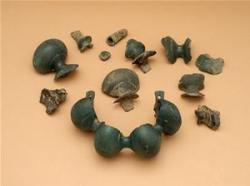 Pakoszówka - Bronze bracelet from the 3rd century BC has been discovered in Pakoszówka near Sanok (Subcarpathian province). This ornament is one of the most valuable objects associated with the Celts discovered in the region Scientists were informed of the discovery by the finder. Only fragments of the bracelet were preserved. According to the archaeologist, it is hard to determine the circumstances in which the ornament ended up in the ground. The fact that it was discovered in the fragmented form drew the attention of scientists - it could be deliberately destroyed. Archaeologists know from previous studies that ancient Celtic settlement had existed near the village Pakoszówka. There are other monuments of this period in the collections of the Historical Museum in Sanok - mainly fragments of pottery, a fragment of glass bracelet and a gold coin. "Maybe the owner of the bracelet lived in the village, the traces of which have been recorded in the same place" - believes Kotowicz. The archaeologist explained that the Celts arrived in the basin of the San approximately in the middle of the 3rd century BC. They came over the Carpathians, from the area of Upper Tisa. According to some researchers, the Subcarpathian region was inhabited by the Anartofrakt tribe mentioned by Ptolemy and Julius Caesar. The Celts were a warrior people, who in the first millennium BC spread to places as distant as the western part of Europe (Iberian Peninsula), and even to Asia Minor. Scientists believe that they originated from the area in the basin of the Upper Rhine, Danube and Main.
Pakoszówka - Bronze bracelet from the 3rd century BC has been discovered in Pakoszówka near Sanok (Subcarpathian province). This ornament is one of the most valuable objects associated with the Celts discovered in the region Scientists were informed of the discovery by the finder. Only fragments of the bracelet were preserved. According to the archaeologist, it is hard to determine the circumstances in which the ornament ended up in the ground. The fact that it was discovered in the fragmented form drew the attention of scientists - it could be deliberately destroyed. Archaeologists know from previous studies that ancient Celtic settlement had existed near the village Pakoszówka. There are other monuments of this period in the collections of the Historical Museum in Sanok - mainly fragments of pottery, a fragment of glass bracelet and a gold coin. "Maybe the owner of the bracelet lived in the village, the traces of which have been recorded in the same place" - believes Kotowicz. The archaeologist explained that the Celts arrived in the basin of the San approximately in the middle of the 3rd century BC. They came over the Carpathians, from the area of Upper Tisa. According to some researchers, the Subcarpathian region was inhabited by the Anartofrakt tribe mentioned by Ptolemy and Julius Caesar. The Celts were a warrior people, who in the first millennium BC spread to places as distant as the western part of Europe (Iberian Peninsula), and even to Asia Minor. Scientists believe that they originated from the area in the basin of the Upper Rhine, Danube and Main.
http://scienceinpoland.pap.pl/en/news/news,404230,valuable-archaeological-discovery-near-sanok.html
CHINE – 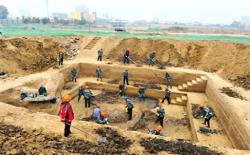 Beijing - Archaeologists have found a massive tomb complex in Beijing, the China News Service reports. The 70-hectare site consists of 129 tombs built over 1,100 years, from the Han dynasty (206BC-AD220) to the Liao dynasty (916AD-1125). The tombs are said to have exquisite murals depicting people and furniture, and artefacts found include porcelain and other funeral paraphernalia, according to the report.
Beijing - Archaeologists have found a massive tomb complex in Beijing, the China News Service reports. The 70-hectare site consists of 129 tombs built over 1,100 years, from the Han dynasty (206BC-AD220) to the Liao dynasty (916AD-1125). The tombs are said to have exquisite murals depicting people and furniture, and artefacts found include porcelain and other funeral paraphernalia, according to the report.
http://www.scmp.com/news/china/article/1742149/around-nation-archaeologists-discover-massive-ancient-tomb-complex?
ROYAUME UNI – 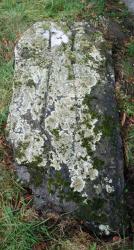 Llantrisant - Llantrisant church now sits in glorious isolation on an exposed hilltop to the south east of the modern hamlet of Trisant and Llyn Frongoch, but clearly served a nearby settlement in the early medieval and medieval period. The medieval church served as the upland chapelry of Llafihangel-y-Creuddyn parish, and belonged to the Deanery of Ultra-Aeron. The medieval church appears to have been abandoned early in the 19th century, with the construction of a new church at nearby Eglwys Newydd. It was clearly ruined by 1834, when it was mapped as a ruin by the Ordnance Survey. The current church, probably the third on the site, was built in the late 19th century to serve the nearby Frongoch lead mines. The original locations of the three stones are uncertain. The two smaller stones appear to have been found during grave digging close to the current south wall of the nave in 1970. All three are recorded in Nancy Edwards’ 2007 A Corpus of Early Medieval Inscribed Stones and Stone Sculptures in Wales. All three stones are derived from local sources carved with crosses, and probably originally intended for use as grave markers. The two smaller stones, which probably date to between the 7th and 9th centuries AD, were lifted and conserved in late 2014. The largest stone, however, required an archaeological watching brief in order to monitor the lifting of the stone and to ensure that there were no buried archaeological remains associated with it. This stone is inscribed with a large outline Latin cross, thought to date to the 9th to 11th century AD.
Llantrisant - Llantrisant church now sits in glorious isolation on an exposed hilltop to the south east of the modern hamlet of Trisant and Llyn Frongoch, but clearly served a nearby settlement in the early medieval and medieval period. The medieval church served as the upland chapelry of Llafihangel-y-Creuddyn parish, and belonged to the Deanery of Ultra-Aeron. The medieval church appears to have been abandoned early in the 19th century, with the construction of a new church at nearby Eglwys Newydd. It was clearly ruined by 1834, when it was mapped as a ruin by the Ordnance Survey. The current church, probably the third on the site, was built in the late 19th century to serve the nearby Frongoch lead mines. The original locations of the three stones are uncertain. The two smaller stones appear to have been found during grave digging close to the current south wall of the nave in 1970. All three are recorded in Nancy Edwards’ 2007 A Corpus of Early Medieval Inscribed Stones and Stone Sculptures in Wales. All three stones are derived from local sources carved with crosses, and probably originally intended for use as grave markers. The two smaller stones, which probably date to between the 7th and 9th centuries AD, were lifted and conserved in late 2014. The largest stone, however, required an archaeological watching brief in order to monitor the lifting of the stone and to ensure that there were no buried archaeological remains associated with it. This stone is inscribed with a large outline Latin cross, thought to date to the 9th to 11th century AD.
http://www.wessexarch.co.uk/blogs/news/2015/03/19/early-medieval-carved-stones-llantrisant?utm_source=feedburner&utm_medium=feed&utm_campaign=Feed%3A+wessexarchaeology+%28Wessex+Archaeology%29